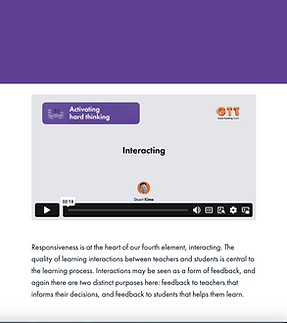Overview

Multiple exposures provide students with multiple opportunities to encounter, engage with, and elaborate on new knowledge and skills.
Research demonstrates deep learning develops over time via multiple,spaced interactions with new knowledge and concepts.
This may require spacing practice over several days, and using different activities to vary the interactions learners have with new knowledge.
Key Elements
-
Students have time to practice what they have learnt
-
Timely feedback provides opportunities for immediate correction and improvement

Related Effect Sizes
-
Time on task – 0.62
-
Spaced practice – 0.71
-
Feedback – 0.73
This strategy is demonstrated when the teacher:
Links multiple exposures to the learning goals
Plans units of work that clearly identify new knowledge and skills that will benefit from multiple exposures
Uses a variety of learning and assessment tasks that vary students’ interactions with the knowledge and/or skills, and support transfer of learning.
This strategy is NOT demonstrated when the teacher:
Repeats the same activity many times with no variation in context, resulting in dull repetition
Does not provide timely feedback, resulting in students repeating mistakes multiple times.
This strategy is demonstrated when students:
Consolidate their learning through opportunities that engage and re-engage them with new content over a period of time
Feel supported and confident about new learning.
Typical problems of practice in this area:
Students aren't clear on the learning objective.
New knowledge and skills are not being identified and exposure is limited.
Students are assessed on objectives after minimal exposures.
Multiple objectives assessed in one assessment and only in one way.
Limited quantity of formative assessments/little to no practice.
Limited ways to demonstrate learning.
Students do not encounter new learning over time.
Students do not know how to ask for/receive support.
Students receive infrequent feedback.
Possible LfL questions to ask students
What are the different ways you get to practise what you have learned?
JS: Before starting a new task, how do your teachers show you examples of what you need to be successful?
JS:How often do you get to practise new skills over and over again?
JS: What are the different ways you get to practise a skill or concept again until you feel confident?
JS: What are the different ways you get to practise a skill or concept again until you feel confident?
-
Learners experience supportive, respectful, and authentic relationships
-
Learners thrive in an environment that is both safe and challenging
-
Learners understand the purpose of their learning
-
Learners readily connect new learning with previous knowledge, concepts and skills
-
Learners feel individually challenged at an appropriate level
-
Learners have increasing agency in their learning
-
Learners receive ongoing feedback
-
Learners experience a range of learning and teaching methodologies
-
Learners have ample opportunities to practise
-
Learners have regular opportunities to collaborate with and learn from others
Reminder of the TLPP

Training Materials from GTT (Great Teaching Toolkit)
How the Great Teaching Toolkit supports this HIT
Element 4.1 Structuring (See article “Useful learning”)
Element 4.1 Structuring (See article “The Benefits of Interleaving Practice”)
Element 4.4 Interacting (See article “Desirable difficulties”)
Element 4.5 Embedding

















